Powell's dignified and institutional lesson to Trump supporters


Getty Images
the three risks
Tariffs, jobs, rate cuts. Avoiding controversy, the Fed chairman explained the central bank's stance and the limits of the American president's economic policy.
On the same topic:
Jerome Powell did not disappoint. His highly anticipated speech at the annual Jackson Hole symposium organized by the Kansas Fed, a traditional global benchmark for central banks and monetary policy, was a blunt lesson in institutional composure and absolute resolve, reiterating the line the Fed has followed since 2018, when he was appointed by Trump for his first term at the Fed. There was no reference to the repeated criticisms directed at him in recent months by Trump, who did not hesitate to call Powell "stupid" and "a jackass." Instead, it was a technical speech on the intrinsic difficulties monetary policy faces in the face of exogenous crises, from the pandemic to high post-Covid inflation , and now the two equally exogenous phenomena that have led the Fed to lower its 2025 US GDP growth forecast.
And here came the real "bite" for the Trump Administration. The main sources of uncertainty in the American market today are represented, Powell said, by the effects on US growth of the structural changes in world trade (obviously, this refers to Trump's tariff bullying) and by recent trends in the labor market, which is slowing its growth rate, increasing the imbalance between supply and demand due to the growing shortage of immigrant workers (another swipe at the Trump Administration), causing unemployment to rise, though not yet at a particularly worrying rate, starting to negatively impact wages, which had been rising strongly in recent years, while labor market participation continues to decline. And this was another implicit response from Powell to Trump's drumbeat of demands for faster interest rate cuts. It is a mistake to make monetary policy dependent on cyclical rather than structural trends, because chasing the economic situation could lead to overly accommodating measures that would rekindle inflation . If we have managed to bring inflation back down from the above 5 percent it had risen to a year ago, to just above 2 percent, and now it has been rising again in recent months, Powell added, it is because we have adopted a policy of moderation that tends to keep interest rates close to the natural rate, the one that allows the economy to function stably, with aggregate output in line with its potential, inflation brought under control, and the maximum employment rate compatible with stable growth and 2 percent inflation.
Powell followed this introduction with an outline of the Fed's second review of monetary policy criteria, which follows the one in 2020. One of the fundamental prerequisites of monetary policy, Powell noted, is its clarity and predictability, so that markets and businesses know what to expect for their consumption and investment decisions. We have addressed the question of whether, in addressing the return of inflation in the post-pandemic era, the policies adopted in 2020 have penalized us in terms of clarity, making us appear too unaccommodative. These years will be remembered as "painful," Powell said, the only concession he made to the obvious bitterness of often being criticized for being too stringent. Therefore, he added, we have decided to remove from our communication references to the natural rate, which create confusion regarding exogenous shocks of uncertain duration, and for the future, we prefer medium- to long-term inflation anchoring targets, rather than dynamic short-term inflation targets. This will provide greater clarity to the Fed's communications at each meeting of its Federal Open Market Committee (the primary body for rates and reserves). Remaining faithful to the Fed's charter, which requires us to treat inflation and employment as two variables, ensuring that the former does not detract from the latter, and that the latter does not increase inflationary risks .
Powell's summary is that the three risks mentioned at the outset—slowly recovering inflation (more pronounced in some sectors), declining employment, and a widening gap between labor supply and demand—"paint a challenging picture that could lead us to intervene." That is, a rate cut in September. A moderate one, however, not the 200-plus basis points demanded by Trump, who is worried about the interest rates on the government debt, which the White House is aggressively raising.
More on these topics:
ilmanifesto




